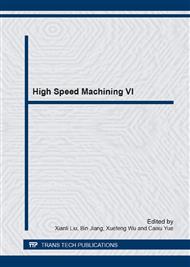[1]
Richard D. Stures, DDS, MS, The history and clinical application of a chairside CAD/CAM dental restoration system, Journal of Shanghai Journal of Stomatology, 2006, 15. 449-455.
Google Scholar
[2]
Ulrich Lohbauer, Frank A. Muller, Anselm Petschelt, Influence of surface roughness on mechanical strength of resin composite versus glass ceramic materials, Journal of MaterialsDental materials, 2008, 24. 250-256.
DOI: 10.1016/j.dental.2007.05.006
Google Scholar
[3]
Julie Z. Zhang , Joseph C. Chenb, E. Daniel Kirby, Surface roughness optimization in an end-milling operation using the Taguchi design method, Journal of Materials Processing Technology, 2006, 184. 233-239.
DOI: 10.1016/j.jmatprotec.2006.11.029
Google Scholar
[4]
Cevdet Gologlu, Nazim Sakarya, The effects of cutter path strategies on surface roughness of pocket milling of 1. 2738 steel based on Taguchi method, Journal of materials processing technology, 2008, 206. 7-15.
DOI: 10.1016/j.jmatprotec.2007.11.300
Google Scholar
[5]
Jae-Seob Kwak, Application of Taguchi and response surface methodologies for geometric error in surface grinding process, Journal of International Journal of Machine Tools & Manufacture, 2005, 45. 327-334.
DOI: 10.1016/j.ijmachtools.2004.08.007
Google Scholar
[6]
Lou MS, Chen JC, Li C, Surface roughness prediction technique for CNC end- milling, Journal of Ind Technol, 1998, 15. 1-6.
Google Scholar
[7]
Hasan O¨ktem, Tuncay Erzurumlu, Mustafa Co¨, A study of the Taguchi optimization method for surface roughness in finish milling of mold surfaces, Journal of Int J Adv Manuf Technol, 2006, 28. 694–700.
DOI: 10.1007/s00170-004-2435-6
Google Scholar
[8]
Yang JL, Chen JC, A systematic approach for identifying optimum surface roughness performance in end-milling operations, Journal of Ind Technol, 2001, 17: 2.
Google Scholar
[9]
Eyup Bagci, Seref Aykut, A study of Taguchi optimization method for identifying optimum surface roughness in CNC face milling of cobalt-based alloy (stellite 6), Journal of Int J Adv Manuf Technol, 2006, 29. 940-947.
DOI: 10.1007/s00170-005-2616-y
Google Scholar
[10]
C.X. (Jack) Feng, X. Wang. Development of empirical models for surface roughness prediction in finish turning, Journal of Advanced manufacturing technology, 2002, 20. 48-356.
DOI: 10.1007/s001700200162
Google Scholar
[11]
Ersan Aslan, Necip Camus_cu, Burak Birgoren, Design optimization of cutting parameters when turning hardened AISI 4140 steel (63 HRC) with Al2O3 + TiCN mixed ceramic tool, Journal of Materials & Design, 2007, 28. 1618-1622.
DOI: 10.1016/j.matdes.2006.02.006
Google Scholar
[12]
J.A. Ghani, I.A. Choudhury, H.H. Hassan, Application of Taguchi method in the optimization of end milling parameters, Journal of Material Processing Technology, 2004, 145. 84-92.
DOI: 10.1016/s0924-0136(03)00865-3
Google Scholar
[13]
Eleana Kontonasakia, Nikolaos Kantiranisb, Lambrini Papadopouloub et. al. Microstructural characterization and comparative evaluation of physical, mechanical and biological properties of three ceramics for metal–ceramic restorations, Journal of Dental materials, (2008).
Google Scholar
[14]
Isabelle Denrya, J. Robert Kelly, State of the art of zirconia for dental applications, Journal of Dental materials, 2008, 24. 299-307.
DOI: 10.1016/j.dental.2007.05.007
Google Scholar
[15]
J. Vivancos, C.J. Luis, L. Costa, J.A. Ort´ız, Optimal machining parameters selection in high speed milling of hardened steels for injection moulds, Journal of Material Processing Technology, 2004, 155-156. 1505-1512.
DOI: 10.1016/j.jmatprotec.2004.04.260
Google Scholar
[16]
Dae Kyun Baek , Tae Jo Kob, Hee Sool Kim, Optimization of feedrate in a face milling operation using a surface roughness model, Journal of International Journal of Machine Tools & Manufacture, Journal of International Journal of Machine Tools & Manufacture, 2001, 41. 451–462.
DOI: 10.1016/s0890-6955(00)00039-0
Google Scholar
[17]
Indrajit Mukherjee, Pradip Kumar Ray, A review of optimization techniques in metal cutting processes, Journal of Computers & Industrial Engineering, 2006, 50. 15–34.
DOI: 10.1016/j.cie.2005.10.001
Google Scholar
[18]
A. Noorul Haq & P, Marimuthu & R. Jeyapaul, Multi response optimization of machining parameters of drilling Al/SiC metal matrix composite using grey relational analysis in the Taguchi method, Journal of Adv Manuf Technol, 2008, 37. 250–255.
DOI: 10.1007/s00170-007-0981-4
Google Scholar
[19]
John L. Yang, Joseph C. Chen, A Systematic Approach for Identifying Optimum Surface Roughness Performance in End-Milling Operations, Journal of industrial technology, 2001, 17. 1-8.
Google Scholar


